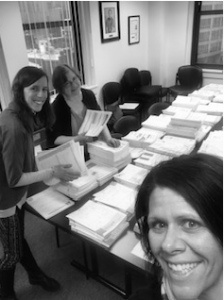Staff Collaborations During COVID: Part 1
When COVID-19 arrived in full force in March 2020, it upended everyone’s way of life, including how we work, teach, and learn at Emerson. Many innovative partnerships were formed among departments in order to create new processes on the fly. Here are a few examples of these collaborations.
As soon as the College switched to remote learning in March 2020, Bob Murphy, Victor Lopez, Tony Ascenso, and Tim MacArthur (Media Technologies and Production) had to quickly put their heads together with the Journalism Department and IT in order to figure out how to run Journalism classes that used the Journalism Production Center’s (JPC) resources—since its television studios were designed solely for in-person recording.
The IT Department worked very long hours over three days to figure out a way to use a VPN, along with other software, to remotely produce news broadcasts.
Janet Kolodzy, Journalism Department chair and professor for JR 322 Television News Producing, also worked on adapting the course’s curriculum so that all students, regardless of their location, would be able to be a part of the broadcast. On the day that classes resumed, MTP, Journalism, and IT representatives were stationed in the JPC’s newsroom to help students get online.
Next, the MTP team met on Zoom to discuss how to remotely record a show for which all of the participants were not physically in the studio. They purchased a license for a software product called ECAMM, which allowed them to record two Skype feeds side by side, as well as add graphics and video in a way that was similar to a studio environment.
By the end of the first week of remote classes, MTP was recording shows for the Television News Producing class. Lopez and Kolodzy were in Massachusetts, Murphy was in Rhode Island, and the anchors were in Massachusetts and California. Adaptations had to be made to the graphics and video format in order for it to work with the software, but in the end, the team successfully recorded several shows.
At the start of the pandemic, there weren’t many software programs available for this type of situation. Now, almost two years later, a number of them are on the market, as remote broadcasting has become the norm in the broadcast industry. Murphy noted that if he and his colleagues ever have to go remote again, there is some new equipment in place that can produce an even better remote broadcast.
***
In 2021, the Iwasaki Library, Office of the General Counsel, and Procurement came together to support the Department of Communication Sciences and Disorders (CSD) with a digitization project.
The CSD residential and online Speech@Emerson program uses clinical assessment protocols to support students learning how to diagnose and treat clients in various academic and clinical courses. On-campus students have been using these paper assessment protocols to practice administering them on each other.
Speech@Emerson students reside in 45 states, so the Speech@Emerson operations team would order hundreds of paper assessment protocols per semester from eight different publishing companies and would inventory, collate, and mail packets containing 54 different protocols to every student and remote instructor. It was not only laborious for the team, but also for other departments, including Mail Services and Student Success.

As the Speech@Emerson program grew, the process of mailing out physical test protocols and managing inventory became more cumbersome. And during the pandemic, the process became unmanageable due to campus and city distancing protocols, company inventory, and fewer workers available on campus to support the manual process.
The Iwasaki Library staff offered to partner with CSD by leveraging their expertise in digitization, partnering with publishers, and copyright laws. The goal was to develop a digital protocol library for CSD students and faculty that could be accessed by all CSD department members remotely. To date, five publishers, representing over 45 individual assessment protocols, have partnered with the College on this venture.
This was a true collaboration between many departments, from devising the concept of a digital library; researching, outlining, and submitting proposals to publishers and following up with them; working through the contract process; securing payment; scanning the actual protocols; and publishing and maintaining access to the digital protocol library.
As a result, 1,000 online and residential CSD graduate students and faculty are able to access almost all of the protocols used in the curriculum virtually. This initiative has alleviated numerous hours of manual labor; saved shipping costs; and has cut down on the use of physical materials, which is more economical and environmentally friendly. CSD and Library Services continue to work with the remaining three publishers and are optimistic that they will sign on in the near future.
Stay tuned for more stories of collaboration in Part 2…
Nancy Howell (Communications and Marketing)
